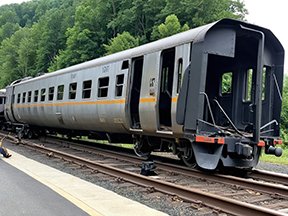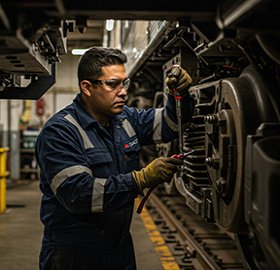Published: September 10, 2015 | Updated: September 19, 2025
Published: September 10, 2015 | Updated: September 19, 2025
Enhancing Railway Safety Through Proactive Maintenance Strategies
Understanding the Roots of Train Malfunctions
 When an airplane encounters a catastrophic failure, the event often garners significant media attention. The relative infrequency of air disasters, coupled with the dramatic nature of such incidents, captures public imagination and can evoke a sense of profound unease. Conversely, while vehicular accidents on roadways occur with much greater regularity, individuals tend to perceive driving as a safer mode of transport compared to options like trains and boats. However, statistical evidence reveals a different reality: airplane accidents happen far less often than tragedies involving other transportation methods. In this article, we'll look at enhancing railway safety through proactive maintenance strategies.
When an airplane encounters a catastrophic failure, the event often garners significant media attention. The relative infrequency of air disasters, coupled with the dramatic nature of such incidents, captures public imagination and can evoke a sense of profound unease. Conversely, while vehicular accidents on roadways occur with much greater regularity, individuals tend to perceive driving as a safer mode of transport compared to options like trains and boats. However, statistical evidence reveals a different reality: airplane accidents happen far less often than tragedies involving other transportation methods. In this article, we'll look at enhancing railway safety through proactive maintenance strategies.
Despite the perception of trains as a secure mode of travel, data indicates a considerable number of reported incidents annually. Each year, numerous train derailments take place, resulting in financial repercussions, injuries, and, regrettably, fatalities. While a significant portion of railway-related deaths involves individuals struck while on the tracks, the issue of derailments themselves warrants serious consideration. The underlying causes of these incidents often point toward systemic challenges within railway infrastructure and maintenance practices.
The Critical Role of Infrastructure and Maintenance
Surprisingly, the primary factors contributing to train derailments do not typically involve external elements like obstructions on the tracks. Instead, the major causes overwhelmingly relate to the condition of the railway infrastructure itself, particularly inadequate upkeep and the presence of broken rails. Other contributing factors, such as train alignment issues and bearing failures, also play a role, ranking among the more frequent causes of derailments. Ultimately, these failures underscore a fundamental need for diligent and effective maintenance protocols.
Just as industrial facilities necessitate routine maintenance for their machinery and equipment, railway companies face an analogous requirement for their extensive networks. The challenge, however, often lies in the allocation of resources, specifically investment, and budgeting–concerns familiar to professionals in the reliability and maintenance sectors.
As railway tracks age and endure constant stress from heavy loads and environmental factors, they demand timely repair or complete replacement. Ideally, a proactive approach involving routine preventive maintenance would significantly mitigate the risk of dangerous incidents and costly derailments. While budgetary constraints can present obstacles, strategic implementation of technology and optimized workflows can maximize the impact of available resources.
 Leveraging CMMS for Proactive Prevention
Leveraging CMMS for Proactive Prevention
One powerful tool available to railway companies seeking to enhance safety and efficiency is the implementation of a Computerized Maintenance Management System (CMMS). A CMMS offers a centralized platform to organize and manage all aspects of maintenance activities related to both trains and railway infrastructure. In a manufacturing or warehousing environment, a system for tracking machinery and spare parts proves indispensable. The railway industry, with its complex array of components ranging from spikes and rails to intricate engine parts, presents a similar, if not greater, need for meticulous asset tracking and management. A well-implemented CMMS serves as this crucial asset-tracking system, enabling organizations to control costs effectively and respond swiftly and strategically when equipment failures occur.
Centralized Asset Management
A CMMS provides a comprehensive inventory of all railway assets, including rolling stock, track segments, signaling systems, and station equipment. This centralized database allows maintenance personnel to access detailed information about each asset, such as its purchase date, maintenance history, specifications, and warranty details. Accurate asset tracking forms the foundation for effective maintenance planning and execution. By knowing the location and status of every asset, railway companies can schedule inspections and maintenance tasks proactively, minimizing the likelihood of unexpected breakdowns.
Proactive Maintenance Scheduling
The scheduling capabilities of a CMMS are instrumental in shifting from reactive to proactive maintenance strategies. Instead of waiting for failures to occur, maintenance teams can use the CMMS to establish preventive maintenance schedules based on factors like usage, time, or condition monitoring data. The system can automatically generate work orders for routine inspections, lubrication, adjustments, and replacements, ensuring that critical maintenance tasks are performed on time. This approach helps identify and address potential issues before they escalate into major problems that could lead to malfunctions or derailments.
Efficient Work Order Management
A CMMS facilitates the entire work order lifecycle, from creation to completion. When a maintenance task is required, a work order can be easily generated within the system. The work order details:
- The type of job.
- The job's priority.
- The specific asset.
- The job's location.
- The job's details.
- Relevant checklists.
- Safety documentation through attachments.
- The relevant inventory and its location(s).
- Assigned personnel.
Maintenance technicians can access work orders electronically, update their status in real-time, and record the work performed, including parts used and any observations made. This efficient work order management ensures that maintenance tasks are carried out in a timely and organized manner, improving overall maintenance effectiveness.
Discover how streamlined maintenance processes can elevate production. Learn more.
Comprehensive Documentation and Knowledge Management
A CMMS serves as a central repository for all maintenance-related documentation, including equipment manuals, schematics, maintenance procedures, safety guidelines, and vendor information. This readily accessible knowledge base empowers maintenance personnel with the information they need to perform their tasks effectively and safely.
Furthermore, the CMMS can store a complete history of maintenance activities for each asset, providing valuable insights into equipment performance trends, failure patterns, and the effectiveness of different maintenance strategies. This historical data supports informed decision-making regarding maintenance planning, asset replacement, and process improvements.
Budget Control and Cost Management
Maintenance software also offers significant benefits in terms of budget control and cost management. By tracking labor costs, material expenses, and downtime associated with maintenance activities, the CMMS provides a clear picture of maintenance spending. This data enables railway companies to identify areas where managers can reduce costs, negotiate better prices with vendors, and make informed decisions about resource allocation. Furthermore, by preventing costly breakdowns and extending the lifespan of assets through proactive maintenance, a CMMS contributes to significant long-term cost savings.
Enhanced Reporting and Analysis
The reporting and analytics capabilities of a CMMS provide valuable insights into maintenance performance and asset reliability. The system can generate a variety of reports, including work order completion rates, mean time between failures (MTBF), mean time to repair (MTTR), maintenance costs by asset, and compliance with regulatory requirements. These reports provide management with the data they need to assess the effectiveness of maintenance strategies, identify areas for improvement, and make data-driven decisions to enhance safety and operational efficiency. Sharing relevant reports with stakeholders, including CEOs, government agencies, and regulatory commissions, demonstrates a commitment to safety and accountability.
While the overall incidence of severe incidents in the railway industry may appear relatively low compared to other forms of transportation, the implementation and diligent use of a CMMS can undeniably contribute to an even safer and more reliable railway system. For railway companies not yet leveraging the power of maintenance software, understanding its potential benefits represents a crucial step toward a future with fewer disruptions and enhanced operational integrity.
In the intricate dance of engineering and operation that defines modern railway systems, vigilance and proactive intervention form the bedrock of safety. The unseen efforts of maintenance professionals, often working behind the scenes, constitute a vital layer of protection for both passengers and infrastructure. Embracing technological solutions, such as CMMS, represents not merely an upgrade in efficiency but a fundamental commitment to preventing potential hazards and ensuring the continued reliability of this essential mode of transportation for communities and economies alike.
FAQs
How does proactive maintenance improve railway safety?
Proactive maintenance prevents equipment failures and track issues, reducing derailments and accidents.
What is the role of CMMS in railway maintenance?
A CMMS centralizes asset tracking, schedules inspections, and manages work orders to ensure timely preventive maintenance.
Why is centralized asset management important for trains and tracks?
It provides detailed information on every asset, enabling accurate inspections, maintenance planning, and cost control.
How does CMMS help with work order management in railways?
It tracks the lifecycle of maintenance tasks, assigns personnel, and records work performed to improve efficiency and accountability.
Can MAPCON CMMS enhance railway safety reporting and analytics?
Yes, it generates reports on maintenance performance, asset reliability, and compliance to support informed decision-making.
What are the budgetary benefits of using a CMMS for railway maintenance?
A CMMS tracks labor, material, and downtime costs, helping companies reduce expenses and extend asset lifespans.
MAPCON | 800-922-4336
MAPCON CMMS software empowers you to plan and execute PM tasks flawlessly, thanks to its wealth of features and customizable options. Want to see it for yourself? Click the button below to get your FREE 30-day trial of MAPCON!
Try It FREE!